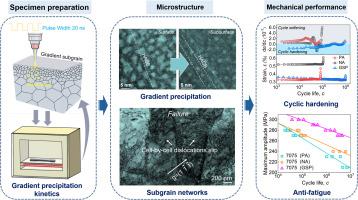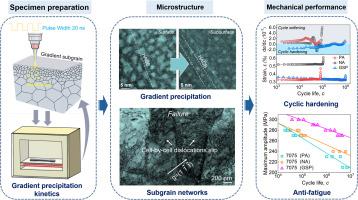利用梯度亚晶-纳米沉淀复合结构提高高强度铝合金的循环可靠性
IF 9.3
1区 材料科学
Q1 MATERIALS SCIENCE, MULTIDISCIPLINARY
引用次数: 0
摘要
循环可靠性是材料在循环载荷下机械稳定性的一个关键指标,它与疲劳性能有着内在的联系。析出强化高强铝合金在平均应力为正的非对称应力循环下会发生明显的循环软化,从而诱发过早疲劳失效。在这里,我们报道了一种具有双梯度结构的高强度铝合金,具有亚晶粒和纳米沉淀,具有显着的抗循环软化能力,从而使疲劳寿命提高了近两个数量级。这种优异的循环稳定性源于这种梯度亚晶纳米沉淀结构固有的快速动态硬化响应和高机械能量耗散。具体来说,亚晶网络和分级沉淀分布之间的协同作用将位错行为从交叉滑移重新配置为平面滑移,同时将位错破碎为细滑移单元。这些独特的相互作用促进了稳定的循环硬化和高内部阻尼。从而有效地抑制了应变局部化,显著延缓了裂纹的萌生和扩展。这种复合梯度策略为设计抗疲劳铝合金提供了一种新的范例。本文章由计算机程序翻译,如有差异,请以英文原文为准。


Taming cyclic reliability in high-strength Al alloys via gradient subgrain-nanoprecipitate composite structures
Cyclic reliability, a key indicator of a material’s mechanical stability under cyclic loading, is inherently tied to fatigue performance. Precipitation-strengthened high-strength Al alloys typically undergo significant cyclic softening under asymmetric stress cycles with a positive mean stress, thereby inducing premature fatigue failure. Here, we report a high-strength Al alloy engineered with a dual-gradient architecture, featuring both subgrains and nanoprecipitates, which displays remarkable resistance to cyclic softening, resulting in a nearly two-order-of-magnitude enhancement in fatigue life. This superior cyclic stability stems from the rapid dynamic hardening response and high mechanical energy dissipation intrinsic to this gradient subgrain-nanoprecipitate structure. Specifically, the synergistic interaction between the subgrain network and graded precipitate distribution reconfigures dislocation behavior from cross-slip to planar slip, while fragmenting dislocations into fine slip units. These unique interactions facilitate stable cyclic hardening and high internal damping. Consequently, strain localization is effectively suppressed, and both crack initiation and propagation are significantly delayed. This composite gradient strategy provides a novel paradigm for designing fatigue-resistant Al alloys.
求助全文
通过发布文献求助,成功后即可免费获取论文全文。
去求助
来源期刊

Acta Materialia
工程技术-材料科学:综合
CiteScore
16.10
自引率
8.50%
发文量
801
审稿时长
53 days
期刊介绍:
Acta Materialia serves as a platform for publishing full-length, original papers and commissioned overviews that contribute to a profound understanding of the correlation between the processing, structure, and properties of inorganic materials. The journal seeks papers with high impact potential or those that significantly propel the field forward. The scope includes the atomic and molecular arrangements, chemical and electronic structures, and microstructure of materials, focusing on their mechanical or functional behavior across all length scales, including nanostructures.
 求助内容:
求助内容: 应助结果提醒方式:
应助结果提醒方式:


